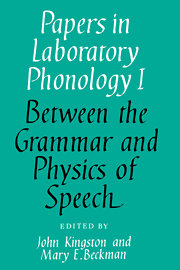Book contents
- Frontmatter
- Contents
- List of contributors
- Acknowledgements
- 1 Introduction
- 2 Where phonology and phonetics intersect: the case of Hausa intonation
- 3 Metrical representation of pitch register
- 4 The status of register in intonation theory: comments on the papers by Ladd and by Inkelas and Leben
- 5 The timing of prenuclear high accents in English
- 6 Alignment and composition of tonal accents: comments on Silverman and Pierrehumberf's paper
- 7 Macro and micro F0 in the synthesis of intonation
- 8 The separation of prosodies: comments on Kohler's paper
- 9 Lengthenings and shortenings and the nature of prosodic constituency
- 10 On the nature of prosodic constituency: comments on Beckman and Edwards's paper
- 11 Lengthenings and the nature of prosodic constituency: comments on Beckman and Edwards's paper
- 12 From performance to phonology: comments on Beckman and Edwards's paper
- 13 The Delta programming language: an integrated approach to nonlinear phonology, phonetics, and speech synthesis
- 14 The phonetics and phonology of aspects of assimilation
- 15 On the value of reductionism and formal explicitness in phonological models: comments on Ohala's paper
- 16 A response to Pierrehumbert's commentary
- 17 The role of the sonority cycle in core syllabification
- 18 Demisyllables as sets of features: comments on Clements's paper
- 19 Tiers in articulatory phonology, with some implications for casual speech
- 20 Toward a model of articulatory control: comments on Browman and Goldstein's paper
- 21 Gestures and autosegments: comments on Browman and Goldstein's paper
- 22 On dividing phonetics and phonology: comments on the papers by Clements and by Browman and Goldstein
- 23 Articulatory binding
- 24 The generality of articulatory binding: comments on Kingston's paper
- 25 On articulatory binding: comments on Kingston's paper
- 26 The window model of coarticulation: articulatory evidence
- 27 Some factors influencing the precision required for articulatory targets: comments on Keating's paper
- 28 Some regularities in speech are not consequences of formal rules: comments on Keating's paper
- Index of names
- Index of subjects
10 - On the nature of prosodic constituency: comments on Beckman and Edwards's paper
Published online by Cambridge University Press: 08 February 2010
- Frontmatter
- Contents
- List of contributors
- Acknowledgements
- 1 Introduction
- 2 Where phonology and phonetics intersect: the case of Hausa intonation
- 3 Metrical representation of pitch register
- 4 The status of register in intonation theory: comments on the papers by Ladd and by Inkelas and Leben
- 5 The timing of prenuclear high accents in English
- 6 Alignment and composition of tonal accents: comments on Silverman and Pierrehumberf's paper
- 7 Macro and micro F0 in the synthesis of intonation
- 8 The separation of prosodies: comments on Kohler's paper
- 9 Lengthenings and shortenings and the nature of prosodic constituency
- 10 On the nature of prosodic constituency: comments on Beckman and Edwards's paper
- 11 Lengthenings and the nature of prosodic constituency: comments on Beckman and Edwards's paper
- 12 From performance to phonology: comments on Beckman and Edwards's paper
- 13 The Delta programming language: an integrated approach to nonlinear phonology, phonetics, and speech synthesis
- 14 The phonetics and phonology of aspects of assimilation
- 15 On the value of reductionism and formal explicitness in phonological models: comments on Ohala's paper
- 16 A response to Pierrehumbert's commentary
- 17 The role of the sonority cycle in core syllabification
- 18 Demisyllables as sets of features: comments on Clements's paper
- 19 Tiers in articulatory phonology, with some implications for casual speech
- 20 Toward a model of articulatory control: comments on Browman and Goldstein's paper
- 21 Gestures and autosegments: comments on Browman and Goldstein's paper
- 22 On dividing phonetics and phonology: comments on the papers by Clements and by Browman and Goldstein
- 23 Articulatory binding
- 24 The generality of articulatory binding: comments on Kingston's paper
- 25 On articulatory binding: comments on Kingston's paper
- 26 The window model of coarticulation: articulatory evidence
- 27 Some factors influencing the precision required for articulatory targets: comments on Keating's paper
- 28 Some regularities in speech are not consequences of formal rules: comments on Keating's paper
- Index of names
- Index of subjects
Summary
Prosodic structure theory
Early work in generative phonology, for example, Chomsky and Halle (1968) and McCawley (1968), made it clear that in order to account for the manner in which rules of phonology apply in environments larger than the word, the sentence must be analyzed into a sequence of domains of different levels. In these works boundary symbols gave notational representation to domains, and there was no necessary coincidence between the boundaries of different domains. The theory that the representation of these phonological domains is instead a hierarchically arranged prosodic constituent structure, as proposed in Selkirk (1978, published in 1981) and developed elsewhere (see references), is based on a number of observations. A first observation is that the limits of higher order (larger) phonological domains systematically coincide with the limits of lower order domains. This leads naturally to a theory of the representation of these domains as a well-formed bracketing or tree, with each instance of a domain of a particular level being a constituent. A tree representation predicts this relation between domains, while boundary theory does not. Moreover, it seems to be the case that a higher order constituent Pn immediately dominates only constituents of the next level down Pn−1.
- Type
- Chapter
- Information
- Papers in Laboratory Phonology , pp. 179 - 200Publisher: Cambridge University PressPrint publication year: 1990
- 5
- Cited by

